
A common misconception that you see and hear nationally, and even amongst Kentucky fans at times, is that Coach Calipari falls short in terms of in-game "X's and O's" coaching decisions. The average fan sees other teams in the SEC run more obvious set plays and they can mistake that as better coaching. However, as a former college basketball coach myself for five seasons, I can say that "over-coaching" can be just as detrimental to a team's success as the alternative. Coach Calipari definitely has a lighter playbook than a lot of his peers, but he instills core principals in his offensive game plan and then gives his talented players the freedom to play within those guidelines. The 2019-2020 version of the 'Cats actually saw as many set play-calls as any recent Kentucky team. Over the next few weeks, I will dive into a play each Sunday and break down the film from a former coach's point-of-view.
The first set in this "Inside the Play" series will be the offense that most Kentucky fans will probably recognize from this season. I think Coach Calipari calls it "Diamond" and that makes some sense after some of the clips I will show, but I would just call it a basic Baseline Runner series. There a few different wrinkles out of this set that developed over the course of the season, but the main principles are pretty simple. This play is actually a perfect example of Coach Cal giving his guys some rules and principles and then letting them improvise and play within those guidelines.

This screenshot above is the "Diamond" set that gives the play its name. The ball will generally be around the top of the key and one guard will get his head under the rim while the other guard is between the free-throw line and the top of the key. The forwards will be a step or two above each block ready to set a down screen for the bottom guard. In this instance, it is Ashton Hagans who is underneath the rim and will trigger the play based on which downscreen he comes off of.
[video width="788" height="442" mp4="https://kentuckysportsradio.com/wp-content/uploads/2020/05/Diamond-1-vs.-UF.mp4"][/video]
Hagans chooses to come off of the Nick Richards down screen to the left-wing and then receives a pass. He just "straight cuts" off the down screen and it happens pretty quick, so instead of spacing to the right-wing like he normally would do, Tyrese Maxey just pops higher at the top of the key and Immanuel Quickley waits to see what Ashton Hagans will do next. Hagans comes back towards the ball which triggers Quickley to cut through to the left corner. As they did a lot last season, when the shot clock wound down, the ball ends up in Hagans' hands and Nick Richards runs into a ball screen. This example of "Diamond" doesn't necessarily run all the way through, but the initial formation is a good way to show how the play looks.

Here is another look at the beginning of "Diamond." Tyrese Maxey has the ball at the top of the key as Immanuel Quickley runs the baseline. Again, this was by far Kentucky's most common set play last season. As you will start to see in the next couple of clips, one of the great things about this offensive set is the spacing that it provides allows for the guys to play in space after the initial action.
[video width="788" height="442" mp4="https://kentuckysportsradio.com/wp-content/uploads/2020/05/Baseline-Runner-vs.-Florida.mp4"][/video]
Quickley comes off the E.J. Montgomery down screen to the right-wing, which triggers Johnny Juzang to space away to the left-wing. Quickley's defender goes "up through" the screen that triggers Quickley to "flare" and gets his defender on the high side, giving him some space for a baseline driver. The baseline drive collapses the defense and the ball is moved to Tyrese Maxey at the top of the key. The Florida defender gives a poor closeout and the lane is essentially wide open for Maxey to drive in and finish with one of his patented floaters.

Here is the last clip we will break down for this Diamond series. We will tackle a few of the additional counters that come off of this play in a separate post. Again, the ball is at the top of the key as Maxey starts to run the baseline and gets his head under the rim with Quickley around the free-throw line.
[video width="790" height="442" mp4="https://kentuckysportsradio.com/wp-content/uploads/2020/05/Keion-J-vs.-UF.mp4"][/video]
In this scenario, instead of continuing to run the baseline, Maxey stops around the rim and comes back off the Keion Brooks down screen. His defender "chases" him off the down screen which triggers Maxey to "curl" cut. Ashton Hagans' defender is playing off him quite a bit so Hagans can't get the ball delivered to Maxey. After Maxey pops out to the left-wing to get a catch, Brooks follows him out to set a side ball screen. Maxey tries to reject the ball screen and drive baseline but gets cut off and hits Keion at the wing. There are two primary things to point out in the play.

The best part about how this play developed, as I touched on in the previous clip as well, is the spacing that gets set up. E.J. Montgomery is spaced at about 15 feet in the short corner, while both Quickley and Hagans are spaced high and wide on the right-wing. The second great part of this play, if you go back to the video to the point where Maxey receives the handoff from Brooks, you will see something that makes Maxey a lottery pick. Instead of rushing the play and throwing it back to Brooks after one dribble, Maxey takes a key second dribble to make the help defender stay a step longer. This leaves Keion Brooks wide open for a 15-foot jump shot. Absolutely beautiful basketball!
Using these three clips to breakdown the Diamond/Baseline Runner set not only shows why Coach Calipari can easily be slighted in terms of his X's and O's prowess, but is also a perfect example of what coaching basketball is like in general. Coach Cal puts his guys in some initial action to get the ball moved to both sides of the floor and create optimal spacing. However, after that initial set action, none of these three possessions ended in scoring directly off of the screening action within the set play. Instead, the scoring came later in the possession after an extra ball reversal and thanks to excellent spacing as a result of that initial set play. Some fans across the country will see the Maxey floater or the handoff and toss back to Keion Brooks as nothing more than "guys making plays" and that is somewhat true. However, that is also what coaching at the highest levels is. Coach Calipari is one of the best at putting his players in a position to succeed offensively and these clips show that skill of his.
@BRamseyKSR A common misconception that you see and hear nationally, and even amongst Kentucky fans at times, is that Coach Calipari falls short in terms of in-game "X's and O's" coaching decisions. The average fan sees other teams in the SEC run more obvious set plays and they can mistake that as better coaching. However, as a former college basketball coach myself for five seasons, I can say that "over-coaching" can be just as detrimental to a team's success as the alternative. Coach Calipari definitely has a lighter playbook than a lot of his peers, but he instills core principals in his offensive game plan and then gives his talented players the freedom to play within those guidelines. The 2019-2020 version of the 'Cats actually saw as many set play-calls as any recent Kentucky team. Over the next few weeks, I will dive into a play each Sunday and break down the film from a former coach's point-of-view.
The first set in this "Inside the Play" series will be the offense that most Kentucky fans will probably recognize from this season. I think Coach Calipari calls it "Diamond" and that makes some sense after some of the clips I will show, but I would just call it a basic Baseline Runner series. There a few different wrinkles out of this set that developed over the course of the season, but the main principles are pretty simple. This play is actually a perfect example of Coach Cal giving his guys some rules and principles and then letting them improvise and play within those guidelines.
A common misconception that you see and hear nationally, and even amongst Kentucky fans at times, is that Coach Calipari falls short in terms of in-game "X's and O's" coaching decisions. The average fan sees other teams in the SEC run more obvious set plays and they can mistake that as better coaching. However, as a former college basketball coach myself for five seasons, I can say that "over-coaching" can be just as detrimental to a team's success as the alternative. Coach Calipari definitely has a lighter playbook than a lot of his peers, but he instills core principals in his offensive game plan and then gives his talented players the freedom to play within those guidelines. The 2019-2020 version of the 'Cats actually saw as many set play-calls as any recent Kentucky team. Over the next few weeks, I will dive into a play each Sunday and break down the film from a former coach's point-of-view.
The first set in this "Inside the Play" series will be the offense that most Kentucky fans will probably recognize from this season. I think Coach Calipari calls it "Diamond" and that makes some sense after some of the clips I will show, but I would just call it a basic Baseline Runner series. There a few different wrinkles out of this set that developed over the course of the season, but the main principles are pretty simple. This play is actually a perfect example of Coach Cal giving his guys some rules and principles and then letting them improvise and play within those guidelines.
 This screenshot above is the "Diamond" set that gives the play its name. The ball will generally be around the top of the key and one guard will get his head under the rim while the other guard is between the free-throw line and the top of the key. The forwards will be a step or two above each block ready to set a down screen for the bottom guard. In this instance, it is Ashton Hagans who is underneath the rim and will trigger the play based on which downscreen he comes off of.
[video width="788" height="442" mp4="https://kentuckysportsradio.com/wp-content/uploads/2020/05/Diamond-1-vs.-UF.mp4"][/video]
Hagans chooses to come off of the Nick Richards down screen to the left-wing and then receives a pass. He just "straight cuts" off the down screen and it happens pretty quick, so instead of spacing to the right-wing like he normally would do, Tyrese Maxey just pops higher at the top of the key and Immanuel Quickley waits to see what Ashton Hagans will do next. Hagans comes back towards the ball which triggers Quickley to cut through to the left corner. As they did a lot last season, when the shot clock wound down, the ball ends up in Hagans' hands and Nick Richards runs into a ball screen. This example of "Diamond" doesn't necessarily run all the way through, but the initial formation is a good way to show how the play looks.
This screenshot above is the "Diamond" set that gives the play its name. The ball will generally be around the top of the key and one guard will get his head under the rim while the other guard is between the free-throw line and the top of the key. The forwards will be a step or two above each block ready to set a down screen for the bottom guard. In this instance, it is Ashton Hagans who is underneath the rim and will trigger the play based on which downscreen he comes off of.
[video width="788" height="442" mp4="https://kentuckysportsradio.com/wp-content/uploads/2020/05/Diamond-1-vs.-UF.mp4"][/video]
Hagans chooses to come off of the Nick Richards down screen to the left-wing and then receives a pass. He just "straight cuts" off the down screen and it happens pretty quick, so instead of spacing to the right-wing like he normally would do, Tyrese Maxey just pops higher at the top of the key and Immanuel Quickley waits to see what Ashton Hagans will do next. Hagans comes back towards the ball which triggers Quickley to cut through to the left corner. As they did a lot last season, when the shot clock wound down, the ball ends up in Hagans' hands and Nick Richards runs into a ball screen. This example of "Diamond" doesn't necessarily run all the way through, but the initial formation is a good way to show how the play looks.
 Here is another look at the beginning of "Diamond." Tyrese Maxey has the ball at the top of the key as Immanuel Quickley runs the baseline. Again, this was by far Kentucky's most common set play last season. As you will start to see in the next couple of clips, one of the great things about this offensive set is the spacing that it provides allows for the guys to play in space after the initial action.
[video width="788" height="442" mp4="https://kentuckysportsradio.com/wp-content/uploads/2020/05/Baseline-Runner-vs.-Florida.mp4"][/video]
Quickley comes off the E.J. Montgomery down screen to the right-wing, which triggers Johnny Juzang to space away to the left-wing. Quickley's defender goes "up through" the screen that triggers Quickley to "flare" and gets his defender on the high side, giving him some space for a baseline driver. The baseline drive collapses the defense and the ball is moved to Tyrese Maxey at the top of the key. The Florida defender gives a poor closeout and the lane is essentially wide open for Maxey to drive in and finish with one of his patented floaters.
Here is another look at the beginning of "Diamond." Tyrese Maxey has the ball at the top of the key as Immanuel Quickley runs the baseline. Again, this was by far Kentucky's most common set play last season. As you will start to see in the next couple of clips, one of the great things about this offensive set is the spacing that it provides allows for the guys to play in space after the initial action.
[video width="788" height="442" mp4="https://kentuckysportsradio.com/wp-content/uploads/2020/05/Baseline-Runner-vs.-Florida.mp4"][/video]
Quickley comes off the E.J. Montgomery down screen to the right-wing, which triggers Johnny Juzang to space away to the left-wing. Quickley's defender goes "up through" the screen that triggers Quickley to "flare" and gets his defender on the high side, giving him some space for a baseline driver. The baseline drive collapses the defense and the ball is moved to Tyrese Maxey at the top of the key. The Florida defender gives a poor closeout and the lane is essentially wide open for Maxey to drive in and finish with one of his patented floaters.
 Here is the last clip we will break down for this Diamond series. We will tackle a few of the additional counters that come off of this play in a separate post. Again, the ball is at the top of the key as Maxey starts to run the baseline and gets his head under the rim with Quickley around the free-throw line.
[video width="790" height="442" mp4="https://kentuckysportsradio.com/wp-content/uploads/2020/05/Keion-J-vs.-UF.mp4"][/video]
In this scenario, instead of continuing to run the baseline, Maxey stops around the rim and comes back off the Keion Brooks down screen. His defender "chases" him off the down screen which triggers Maxey to "curl" cut. Ashton Hagans' defender is playing off him quite a bit so Hagans can't get the ball delivered to Maxey. After Maxey pops out to the left-wing to get a catch, Brooks follows him out to set a side ball screen. Maxey tries to reject the ball screen and drive baseline but gets cut off and hits Keion at the wing. There are two primary things to point out in the play.
Here is the last clip we will break down for this Diamond series. We will tackle a few of the additional counters that come off of this play in a separate post. Again, the ball is at the top of the key as Maxey starts to run the baseline and gets his head under the rim with Quickley around the free-throw line.
[video width="790" height="442" mp4="https://kentuckysportsradio.com/wp-content/uploads/2020/05/Keion-J-vs.-UF.mp4"][/video]
In this scenario, instead of continuing to run the baseline, Maxey stops around the rim and comes back off the Keion Brooks down screen. His defender "chases" him off the down screen which triggers Maxey to "curl" cut. Ashton Hagans' defender is playing off him quite a bit so Hagans can't get the ball delivered to Maxey. After Maxey pops out to the left-wing to get a catch, Brooks follows him out to set a side ball screen. Maxey tries to reject the ball screen and drive baseline but gets cut off and hits Keion at the wing. There are two primary things to point out in the play.
 The best part about how this play developed, as I touched on in the previous clip as well, is the spacing that gets set up. E.J. Montgomery is spaced at about 15 feet in the short corner, while both Quickley and Hagans are spaced high and wide on the right-wing. The second great part of this play, if you go back to the video to the point where Maxey receives the handoff from Brooks, you will see something that makes Maxey a lottery pick. Instead of rushing the play and throwing it back to Brooks after one dribble, Maxey takes a key second dribble to make the help defender stay a step longer. This leaves Keion Brooks wide open for a 15-foot jump shot. Absolutely beautiful basketball!
Using these three clips to breakdown the Diamond/Baseline Runner set not only shows why Coach Calipari can easily be slighted in terms of his X's and O's prowess, but is also a perfect example of what coaching basketball is like in general. Coach Cal puts his guys in some initial action to get the ball moved to both sides of the floor and create optimal spacing. However, after that initial set action, none of these three possessions ended in scoring directly off of the screening action within the set play. Instead, the scoring came later in the possession after an extra ball reversal and thanks to excellent spacing as a result of that initial set play. Some fans across the country will see the Maxey floater or the handoff and toss back to Keion Brooks as nothing more than "guys making plays" and that is somewhat true. However, that is also what coaching at the highest levels is. Coach Calipari is one of the best at putting his players in a position to succeed offensively and these clips show that skill of his.
@BRamseyKSR
The best part about how this play developed, as I touched on in the previous clip as well, is the spacing that gets set up. E.J. Montgomery is spaced at about 15 feet in the short corner, while both Quickley and Hagans are spaced high and wide on the right-wing. The second great part of this play, if you go back to the video to the point where Maxey receives the handoff from Brooks, you will see something that makes Maxey a lottery pick. Instead of rushing the play and throwing it back to Brooks after one dribble, Maxey takes a key second dribble to make the help defender stay a step longer. This leaves Keion Brooks wide open for a 15-foot jump shot. Absolutely beautiful basketball!
Using these three clips to breakdown the Diamond/Baseline Runner set not only shows why Coach Calipari can easily be slighted in terms of his X's and O's prowess, but is also a perfect example of what coaching basketball is like in general. Coach Cal puts his guys in some initial action to get the ball moved to both sides of the floor and create optimal spacing. However, after that initial set action, none of these three possessions ended in scoring directly off of the screening action within the set play. Instead, the scoring came later in the possession after an extra ball reversal and thanks to excellent spacing as a result of that initial set play. Some fans across the country will see the Maxey floater or the handoff and toss back to Keion Brooks as nothing more than "guys making plays" and that is somewhat true. However, that is also what coaching at the highest levels is. Coach Calipari is one of the best at putting his players in a position to succeed offensively and these clips show that skill of his.
@BRamseyKSR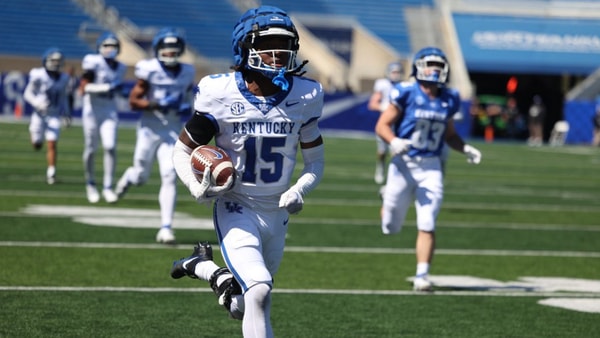
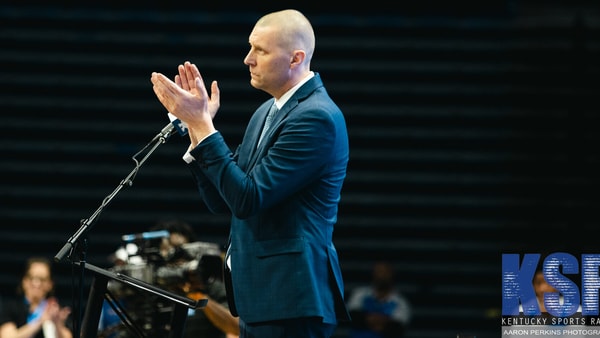
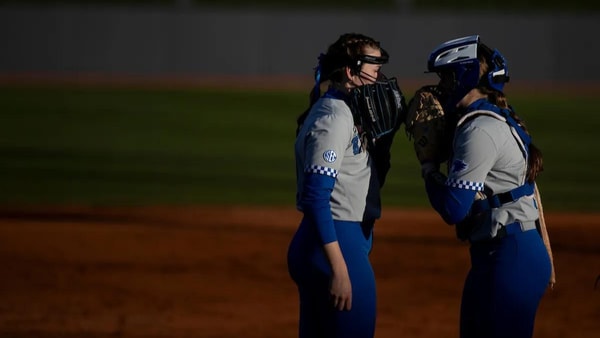
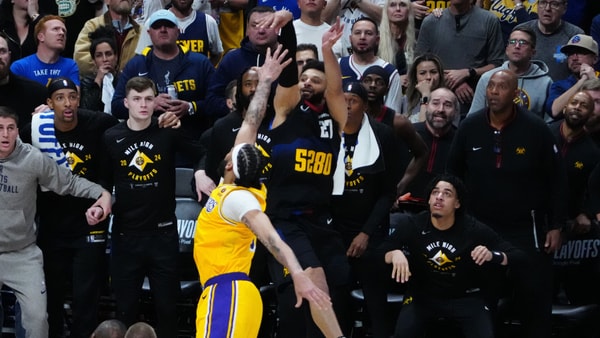

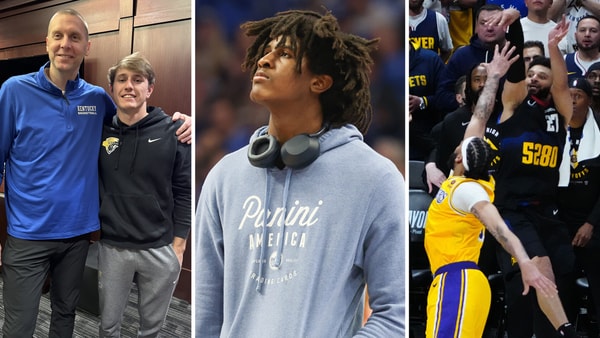
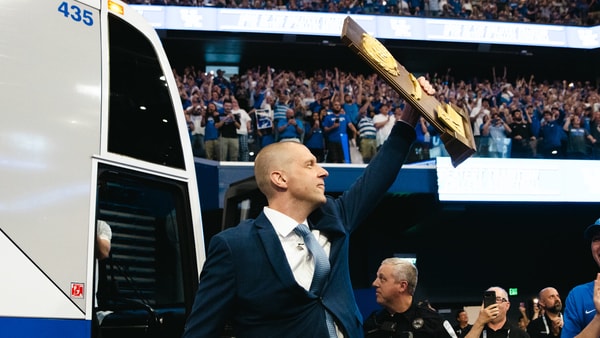
Discuss This Article
Comments have moved.
Join the conversation and talk about this article and all things Kentucky Sports in the new KSR Message Board.
KSBoard